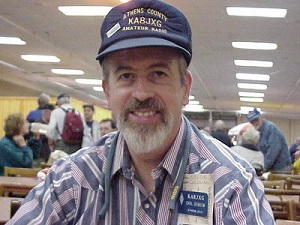 |
N8VZ Carl J. Denbow Athens, OH QCWA # 34424 |
NOTE: The picture above is from 1999 Dayton Hamvention. I kind of like this photo but the XYL didn't like the whiskers, so I'm now "sans beard."
================================================
I first became a ham in 1981, when I received my Novice license, and the FCC-assigned call -- KA8JXG. Two years later I upgraded to Technician. I remained a technician until April 2000, when I made an administrative upgrade to General by virtue of the new FCC requirements of a maximum of 5 wpm Morse code needed for all license classes. My XYL, a college professor, calls this "ham grade inflation." Nonetheless, I was very happy that this new standard allowed me to upgrade to General. At that point, I began rather serious DX work, compared to my earlier sporadic DX activity. I earned mixed mode DXCC in 2010 with my last dozen or so needed QSOs being mainly on JT65. After final "card counting" at Dayton in 2006, I received my general WAS award. I had first started to work on this in the early 1980s. When I upgraded to General, I also became quite active on that then-newest mode -- PSK31. More recently, I've become fascinated with an even newer digital mode -- JT65. About half of my DX contacts have been on one of these two digital modes. So, I guess I'm kind of a digital guy.
In April 2002, I took the written exam for Extra and passed with a score of eight wrong answers. I used the Gordon West study materials (book and computer program) and the online sample tests and flashcards that are available at W8MHB.org. I highly recommend all of these study aids to the aspiring Extra class operator.
On May 18, 2002, the FCC website showed that my application for the vanity callsign -- N8VZ -- had been approved. Thus began the next chapter in my amateur radio "career."
My HF rigs include: Kenwood TS-590s, Elecraft KX3, and a new Flex 6500 soon. Some of my other station equipment are: Elecraft KAT500 antenna tuner, Elecraft KPA500 amplifier, KPC-3 TNC, and various digital mode interfaces. I also have several HTs as well as a 2M base and mobile rig. Finally, I am the proud owner of a "built-it-myself" K-2. After an almost two year construction period, with a number of delays and periods of "downtime," my K-2 (S/N: 03116) finally had its first QSO in the summer of 2004. For a weekly local 6M AM net I use a Polycomm 6 or a solid state rig, depending on my mood.
The antennas at my QTH include a GAP Titan DX vertical, a Mosley Mini-Beam, an Alpha-Delta 40-80, a Cushcraft MA6V, and the most recent addition a W5GI Mystery Antenna.
My ham radio interests include: PSK31, JT65A, Packet (HF & VHF), SSB, RTTY and QRP. I have done some small-gun contesting on SSB and RTTY. I still enjoy working 6 and 10 meters, when band openings allow. In the summer of 2009 I put an IRLP node (4533) and Echolink (116070) node on the air at 147.445 simplex (PL 77). It's low-profile with 10W output and an antenna on the peak of my roof. I'm a member of 10-10 International (72675), SMIRK (5490), the ARRL, the Christian Amateur Radio Federation (www.carf.net), and the Athens County Amateur Radio Association.
November 19, 2014